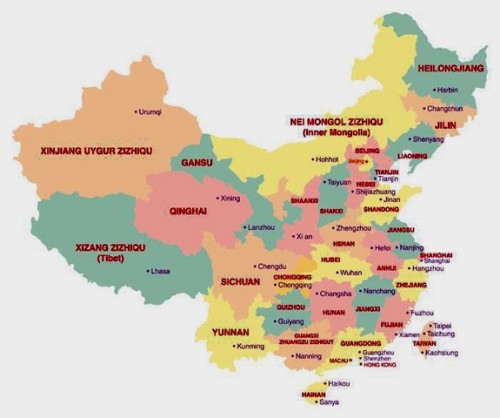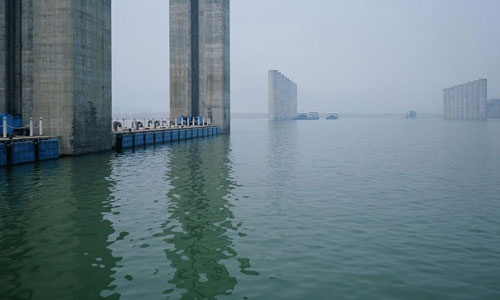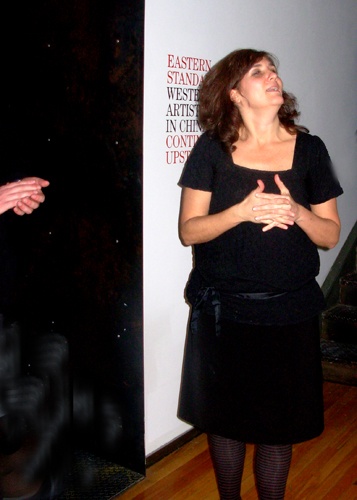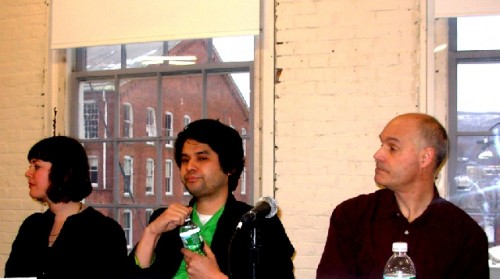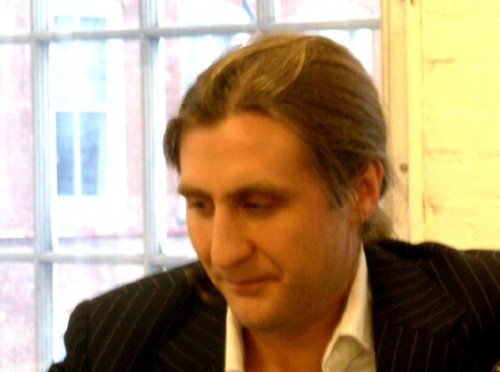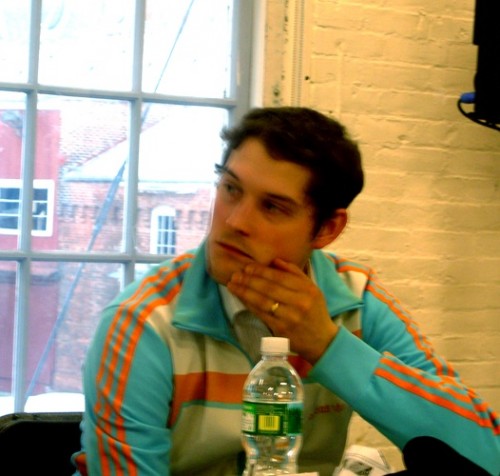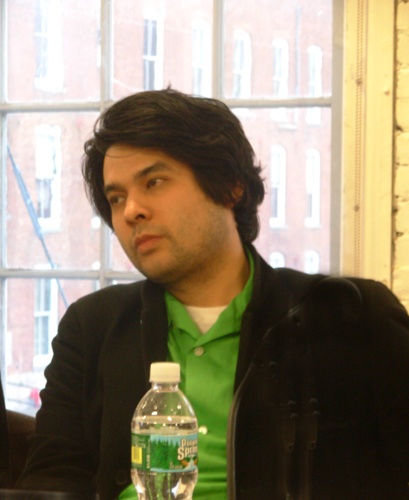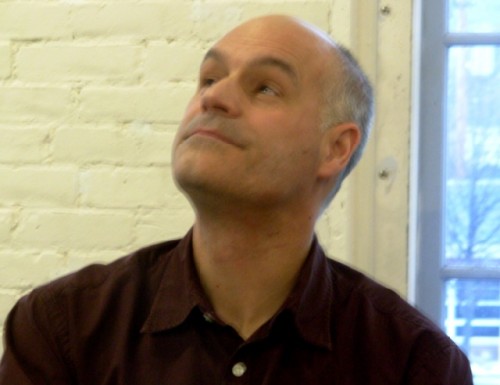Chinese Themed Exhibition for Mass MoCA
Eastern Standards: Western Artists in China
By: Charles Giuliano - Feb 05, 2008
With the exhibition "Eastern Standards: Western Artists in China," which opened this past weekend, Massachusetts Museum of Contemporary Art has installed an intense, information packed exhibition, top heavy with time demanding video works, in a warren of spaces separated by black curtains.
The exhibition, which features several works commissioned for this project, brings together a group of artists, most of whom are in their 30s, from the U.S., Canada, France, Germany, Great Britain, the Netherlands, Puerto Rico, and Sweden. All of these individuals have visited China for varying lengths of time and were inspired to create in a range of media in response to their experiences. This expands on a prior commitment of Mass MoCA to present the work of contemporary Chinese artists. There were major installations in the museum complex's largest spaces by Cai Guo Qiang, in 2003, and Huang Yong Ping, in 2006.
During opening remarks Joe Thompson, director of Mass MoCA, commented that the curator Susan Cross was initially reluctant to undertake such a complex project. But she quickly encountered a great range of material resulting in a content rich exhibition which tackles a vast and perhaps unfathomable topic. He also announced that Cross will soon be visiting China for the first time.
Her hesitation may have derived from the fact that, in a sense, she was in the uncomfortable position of taking on work, more or less, sight unseen. Cross had to trust her curatorial instincts relying on the artists and projects through their eyes and sensibilities. It is clearly a conundrum to curate work from and about a culture you have no first hand knowledge of.
Oddly enough, we had a somewhat similar problem attending a panel discussion with several artists that preceded the opening and opportunity to view their work. So there was a disadvantage of hearing the artists- Patty Chang, David Cotterrell, David Kelley, Oliver Lyons, Alexis Raskin, Walter McConnell, Roma Pas, Lucy Raven and David Thomas- without the ability to connect their comments to actual works, videos, photographs and images. Surely it would have been a far more enriching and insightful experience had we been acquainted with their work. Or, perhaps not.
Oliver Lyons is a musician/ composer who, in 2007, collaborated with the musician Feng Jaingzhou to compose and perform music for the Chinese play "Yan Yu." He informed us that his wife lived in Taiwan three years ago and that he is of half Chinese heritage. He stated that travel to China was a journey and bond which has flourished. They now divide time between studios in China and Brooklyn. In "Electric Shadows" (2007) Lyons and Alexis Raskin create a series of time-lapse videos projected on glass contrasting the new, official China with images of endangered aspects of the culture.
Walter McConnell stated that in 2002 "Our university (New York State College of Ceramics at Alfred University) went to China for six weeks for workshops and symposiums. We explored both industrial production of ceramic art as well as 'mom and pop' studios mostly in the Southern part of China." They visited clay pits and various sites which produced ceramics. "We were there to see processes and traditions which are fast disappearing. Also we visited traditional gardens including instances of some twenty different gardens in a room this size." For this exhibition McConnell has been inspired to create a simulacrum of a Chinoiserie inspired fantasy of a Chinese garden. The piece was created on site with wet clay. The round construction has an outer wall of plastic sheeting which blurs our vision while also keeping the unfired clay moist. The piece will be destroyed and the clay recycled following the exhibition.
In 1999, Patty Chang first visited China as a tourist with her family. "I was born in the United States of Chinese ethnicity," she said. "My Chinese heritage is domestic and was learned at home. My parents left China in 1948-49 when they were nine years old." In 2003, she and her partner, David Kelley, visited Shangri-La near the border with Tibet which became a video commissioned by the Hammer Museum in Los Angeles in 2005. "We compared the mythical city with a real place." Shangri-La was described in James Hilton's 1933 novel "Lost Horizon." Chang was short listed for the 2008 Guggenheim Hugo Boss Prize.
David Kelley started by reading about China and its changes. "I wanted to compare our imagination and the reality of the site," he said. Kelley described an incident in which a submarine on surveillance in the coastal waters off China was navigating without sonar to avoid detection and collided with an unseen obstacle. It was for him a metaphor both tragic and insightful of their experiences of unpredicted cultural collisions. "It represented the landscape of the imagination. The absence and presence of the underwater mountain."
The Dutch artist, Roma Pas, was a resident at the Chinese European Art Center in Xiamen, China in 2003-2004. In her installation "Rendering" (2005-2006) there are two projections of construction sites in many cities. She focuses on the use of bamboo scaffolding which slowly evolved with the workers who construct them eliminated from view. She described the work as driven by "How we relate to images and extensions of our bodies."
David Thomas conveyed a fascination with Asian and Japanese cultures from a very young age. In China he was able to fabricate large banners, such as "Two Steps Forward, Two Steps Back" in this show, with text in English and Chinese, "for a tiny fraction of what it would cost in the West."
This was a theme that several of the artists discussed; the fact that you can make just about anything in China within reason and budget and on any scale. More and more artists are considering China as a place to do ambitious projects. But, as the economy of China becomes ever more robust and dominant, this will change. Currently there is a window of opportunity. The artists also spoke of networking with Chinese artists and artisans. Lucy Raven discussed dividing time with artists, as well as industrialists, as her interest involves tracking copper as it transforms from mines in the U.S. to various forms of fabrication in China.
During a phase of questions from the audience I asked why there had been no mention of the political climate in China. While there was much discussion of a changing economy, and the disappearance of aspects of traditional culture, there was not much sense that China is not a democracy but rather a Marxist nation. The events of Tiananmen Square were as recent as 1989 or, before that, the Gang of Four, and the Cultural Revolution under Mao. Because of the booming economy there is an illusion of freedom which does not in fact exist.
In response to this an artist commented on the great delay in receiving e mail and that it is even known to disappear. There is a constant level of police and government surveillance.
David Cotterrell commented on encountering daunting extremes of wealth and poverty. His work focuses on the rapid construction of sprawling, high rise complexes. In the show he has a dense installation of plaster models of these tall buildings. China is in the midst of constructing the world's largest site specific project, the controversial Three Gorges Dam, which has meant the disruption and relocation of millions of individuals in a vast area that will be flooded. He discussed how, in the West, such a project would be delayed for decades with law suits and eminent domain cases. But, in China, the State owns all property which can be quickly vacated for new construction. He described the rapid razing of poor, working class neighborhoods in Shanghai which are being replaced by high rise constructions.
Many of the individual works in the exhibition poignantly focus on these changes as villages and traditional cultures are demolished in the guise of growth and progress. Perhaps the artists represent a romantic tendency of wanting to discover and record their notions of a more traditional China before it just disappears like the flooding of the Three Gorges Dam.
Some of the most riveting images in the exhibition are the photographs by Edward Burtynsky which depict endless rows of pink suited workers in a factory processing chicken or hanging their uniforms from the balconies of generic worker dormitories. The most compelling video in the exhibition "Lock," by Catherine Yass, projects a real time, slow, grainy depiction of barges rising through a system of locks to navigate a river. It is a metaphor for immensity and change.
The possibility of gaining any real insight about China and its culture is, at best, an intellectual conceit. The scope of the undertaking is too huge to be knowable in anything more than tiny morsels. Just, for the moment, let us crunch some numbers. The approximate world population in 2007 was 6.6 billion. The estimated population of China at that time reached 1.32 billion while the U.S.A. logs in at a rather overcrowded 301,139,000 The entire land mass of China is just less than that of Europe. Approximately 20% of world population is Chinese. This does not calculate those of Chinese heritage living elsewhere in the world.
While the artists offered many unique insights of their experiences of living and working in China, to a greater or lesser degree, they were speaking as artist/ tourists. None of them would aptly be described as Sinologists. This is also reflected in the work that they produced which offers tantalizing glimpses of the culture but not much you can really sink into. When compared, for example, to the depth of the experiences of viewing the work of native Chinese artists such as Huang Yong Ping and Cai Guo Qiang.
There is always the risk of false reporting when "scientists" including anthropologists, sociologists, and even artists, respond to research and experiences of encountering peoples and cultures other than their own. The Native American lawyer, author, and cultural commentator, Vine DeLoria, Jr., wrote about this phenomenon with scathing insight and wit regarding the hordes of researchers who descended on reservations with cameras and tape recorders. It is chilling to read his work as one who has aspired to work with Native artists. Should it be any different when the art world insists on ever more exotic destinations? Cutting edge culture mavens are alert to new markets and areas for globalization. One of the artists commented on attending the first Art Fair in Shanghai which had already hosted a couple of biennales. The gallerists were busy selling their wares to an eager audience of collectors. There was talk, the artist commented, that the Asian/ Chinese market was now so well established that the buzz was that the next such frontier might be India.
In Western Culture there is a long history of looking at and emulating the Exotic East. The French high culture and decorative arts of the 17th and 18th Centuries had its fad for Chinoiserie. During the era of French Impressionism there was the phenomenon of Japonisme as artists emulated what they learned from Japanese scrolls and prints. But these elements in art have been more about the pastiche than reflective of an in depth understanding of cultures, languages and differences. It is more usual to get the look and feel of another remote culture than to understand its essence.
During a scathing rebuttal to fierce reviews of his Venice Biennale, in the January issue of Art Forum, the curator, Robert Storr, aired the dirty linen of attempts to manipulate an open call for projects for presenting African Art in the Arsenale. He discussed how the field has been marked out to by a couple of curators, to the exclusion of others, and he refused to treat the curator, Okwui Enwezor, as the "Viceroy" for African Art. As these exotic global cultures are further opened to Western curators, critics, gallerists, and collectors there is inevitable turf war. As China and India further develop, as markets with vast populations and resources, the impact on the art world will be commensurate. No serious player can afford to ignore these developments.
More than twenty years ago, Kathy Halbreich, now associate director of the Museum of Modern Art, in an interview was prescient when she told me "In the future curators will not be dealing with the art of nations but rather with continents." Today, there are now more than 150 biennials, all over the world, and probably as many art fairs. The commodification of the art world has been both exhilarating and devastating.
Listening to the comments of the panelists at Mass MoCA was particularly absorbing and relevant as Astrid and I also had an all too brief experience as art/ tourists in November of 1999. We participated in a two person exhibition with the German artists, Debora Mache and Anke Erlenhoff, at the Zhu Qi Zhan Museum in Shanghai. I wrote an essay for Mache's catalogue and the German curator and critic, Klaus Honnef, was there in support of Erlenhoff. We encountered first hand issues of bureaucracy as works shipped to the exhibition never cleared customs. Mache showed scrolls, hangings, and small pieces she took to Shanghai in her luggage. Her bags were "lost" on the return trip and my slides and installation shots are the only documents of the work.
Because the opening occurred during the semester I was only able to get a week off from teaching. We flew on a Friday and returned on the following Sunday. I had my usual classes on Monday. It was truly brutal travel but left remarkable experiences and memories. Astrid and I discuss returning to see more of China and other Asian cultures. In addition to the week in China we experienced an amazing train ride to the country and visited the site of several ancient gardens. We also encountered a remarkable range from incredible wealth to grinding poverty. The rapid construction and growth in Shanghai compared to, and far surpassed, the changes we had experienced during several visits to Berlin. There was a further connection between Shanghai and Berlin when we visited the Wannen See Schloss, now a Holocaust study center, which was the site of the notorious Nazi meeting in which the fate of Europe's Jews was decided over lunch.
During the Holocaust only Shanghai would allow entry to its port without passports. It was the most Western of China's cities and produced a remarkably eclectic culture and cuisine. There was the phenomenon of the Shanghai Jews whom the Japanese refused to hand over to their Axis allies. While we visited Wannen See there was a scholarly colloquium of Shanghai's survivors and scholars.
From the vantage point of our tiny glimpse of China, almost a decade ago, I found this Mass Moca panel of artists, and exhibition of their work, both riveting and daunting. There is so much to experience and absorb. One of the great advantages of having a world class contemporary museum as a neighbor is that it affords the luxury of getting to know important work over a stretch of time and many visits. It is possible to drop in and sit with individual works and not have to take it all in at one time.
Which, come to think of it, was rather like visiting China. It will be interesting to learn what Cross experiences. Having worked with these artists surely she will have special insights regarding what to expect and look for. Hopefully, this will lead to further projects for Mass MoCA.

